One of my 6th grade students drew a picture of me on the white board today...I had no idea my nose was so pointy!
Today one of my co-teachers asked me if my culture has any special type of celebration for the ending off of one year and the beginning of another. I said, "Not really, just a big celebration on the 31st." I explained briefly about the way we celebrate and then asked him the same question... "Well, on new years eve we ring a bell and stay up until sunset," (he meant sunrise) "but no alcohol is involved." He then proceeded to tell me that during the whole month of December is when they celebrate with alcohol and then said "So we will have many parties next week, ok?" Hahaha, not that Korea ever needs a reason to drink.
Anyway, so the Bell-ringing ceremony has been the tradition in Korea since 1952. People will gather around the bell tower at temples and toll the bell several times to welcome in the new year. Not just anyone can ring the bell. Participants include celebraties and other people who have played an important role in society.
"The ringing of the bell originated in the Joseon Kingdom (1392-1910). In the early Joseon period, bells at Seoul's four main entrances and four small entrances were rung in the morning and evening to notify the opening and closing of the gates. The bells sounded 33 times in the morning to start the day and 28 times in the evening to announce the curfew."
Koreans are all about food! It's a way of life here, and part of everyday socializing. Not only do people go out for dinners and lunches, but also snack together throughout the day. I thought I'd be eating a lot less here, but I thought wrong hey! Don't get me wrong, I actually love it because by 4pm I'm usually starving so it's great to tame my stomach with a light snack. However, after 'Volleyball Wednesdays' we usually have more than a light snack... more like a huge meal (which then leads to drinking meaning I only leave school some hours later).
At kindergarten there is endless food. Snacks before lunch include sweet potato, donuts, kimbab, songpyeon, yogurt and jam mix, all of which are usually home-made by one of the teachers. Afternoon snacks are usually take-out foods like tteokbokki, pizza, chicken, cake, chilli dogs, etc.
Today I was given this tray:
It's a Vietnamese snack similar to spring rolls, except for the fact that they're not fried. The ingredients include fruit, veggies, prawn or pork and it's wrapped in rice paper. [apparently the korean rice paper isn't exactly the same as the Vietnamese]. I think it's just called a summer roll, but in Korean it's walnamsam.
Served with chilli sauce and a cup of ginger, cinnamon & pinut mix. It was super delish!
October and November are busy months for schools in Korea, not just because of finishing off the syllabus but because they are busy preparing for the school "festival". This I learnt, is just like an end-of year concert for the parents (and sometimes they even participate).
I watched the festivals at each of my schools and took many video clips, but my favourite was by far the kindergarten kids. I found it so fascinating how they are trained from so young to dance and perform.
So here's a clip of the dances the kids had to do. It is evidence of why todays pop stars are like they are.

South Koreans love to brag about their beautiful and distinct four seasons, and they have all the reason to. In Autumn Korea is just too beautiful for words!
One of the cities that Andrew and I have been eager to visit is Gyeongju. The only problem was getting there because it is quite far to travel especially if you are relying on public transport.
With autumn almost over we decided to spend a weekend in Gyeongju to witness it's beauties.
Gyeongju is a historical city~ it is often referred to as the "museum without walls". It was the capital of the ancient kingdom of Silla (about 7th-9th century). Many archaeological sites remain along with a rich ... of cultural. Very worthy of the long journey.
So Friday after school we set off to Jecheon (30 mins) where we got a bus to Daegu. Usually this journey takes 2hr 30min but we took just over 3 hrs because of road works and traffic. From Daegu we took a bus to Gyeongju which is luckily only one hour. Arriving in Gyeongju at about ten thirty we found a motel and called it a night.
Unfortunately the weather wasn't complying with our photographic needs, but nevertheless we set off to make the best of it. Luckily getting around the city is easy.
We took a bus from the train station to Bulguk Temple. The temple itself was one of the more realistic one's I've seen. It was dusty and unpolished~ really adding a sense of historic value to it. The scenery around the temple was gorgeous. There are ponds with huge koi in and the surrounding trees were so colourful.
Outside the main temple area are two pagodas.
From the temple we took a taxi (although buses do run every 40 mins) to Seokguram grotto. It is part of Bulguksa and classified as the 24th National Treasure. Seokoguram grotto is a hermitage and symbolic of the journey into Nirvana.
Unfortunately no photos are allowed, but here's a professional one:
After a hearty meal at an italian restaurant down town we headed back to our motel to throw on a few more layers before continuing the site-seeing.
One of the most famous 'buildings' in Korea is an old observatory. The Cheomseongdae observatory is one of the oldest surviving astronomical observatories in East Asia. I was excited to finally see the real thing ~ and was surprised at how small it was. I just assumed it was bigger but either way it was magnificent.
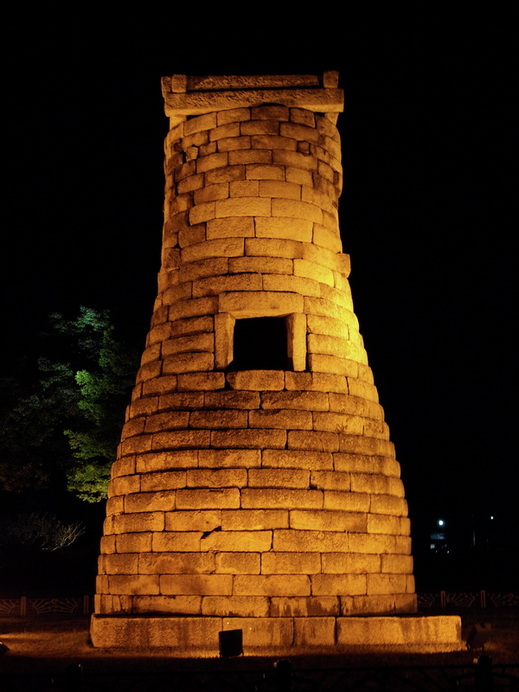
Cheomseongdae
From there we walked to Anapji pond. This artificial pond was part of the palace complex, located near the palace of Silla called Banwolseong. It was contructed in 674CE near the palace, but after the fall of Silla it fell into disrepair for many centuries. In 1974 it was rebuilt as part of a renovation project.

Anapji at night
We decided to get an early start on Sunday morning so we rented bikes from the first place that opened at 8am. (It's was only 7000 for the whole day). We cycled down to Cheomseongdae again and stopped at a nearby scenic park. It was great that the blue skies had opened up for us. While we were taking pictures the weather turned and it started to rain :( which kind of messed up our cycling plans for the day. We made a change to our plans and went to the National Museum of History. There we were able to use audio guides and heard details about the artefacts that were found in the tombs.
The rain had blown over so we cycled back to Anapji pond.
From there we headed back, taking a different route and stopping by the Lotus flower park. (Unfortunately they weren't in bloom~the most beautiful time is in Spring).
Our last stop was Tumuli park. Throughout Gyeongju many mounds or heaps covered in grass can be seen~ these are royal tombs where noble persons were buried with all their belongings. Tumuli park has more than 20 tombs, assumed to be those of Kings and court officials. The tombs range from a height of 1to 23 meters.
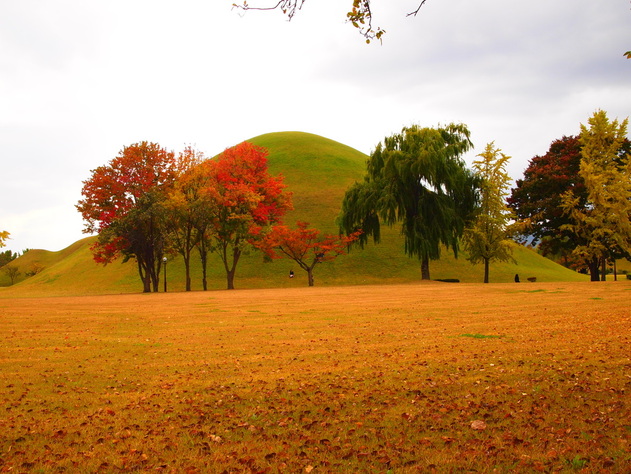
Tumuli park
Gyeongju is one of the most beautiful cities I've been to and would highly recommend doing some research into the history of it and paying it a visit.
A couple of months ago, rumours spread about Lotteria opening in Danyang. Lotteria is the Korean version of Mc Donalds, and I'm not particularly a fan of it, but when you live in a town where the only western food is pizza or chicken then the option of a burger is pretty exciting.
Like with any new shop opening in Korea, there are bright coloured flower things outside to attract attention, not that it's needed ~ people would come without it. Lotteria was packed with (mostly) students and should continue to be full for the next month or so.
This is my toothpaste. Apparently it's "anti-calculus"... I don't know what that means exactly, but hey I don't want calculus on my teeth anyway.
I absolutely hate going to the doctor just because I hate being on anti-biotics. I always try to self-medicate until it gets serious and there are no other options. One of the reasons I hate taking meds in Korea is that you never know what exactly you're taking.
When you go to the pharmacy to collect your prescribed meds they give it to you in seeled packets ~ one sachette per intake. It's all measured out or chopped up so that you take exactly what you need without any fuss. It is pretty cool I guess, but I'd love to know what it is that I'm consuming.
Below is a picture of one day's worth of my tablets. Marked 1 to 4 for each time of the day. Even my cough syrup was measured out into a container so that it's just enough to complete my course.
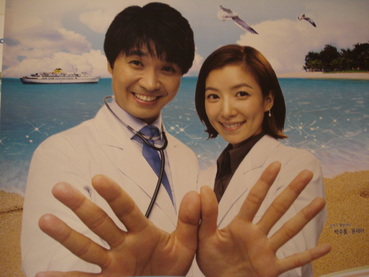
Despite the fact that in Korea it's okay to not cover your mouth when you cough, or to spit on the street, Koreans are actually concerned about hygiene ... when it comes to clean hands.
These are some of the posters at my kindergarten. The first one is a reminder of what you need to do, especially when you have a cold; the other is step-by-step instructions to ensure you've scrubbed all the important parts.

< Please Keep in Mind >
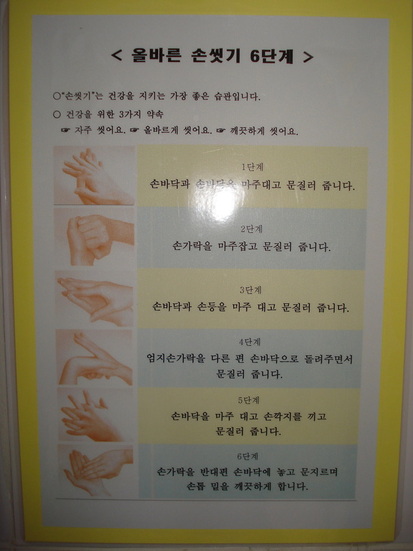
< 6 Steps for Proper Handwashing >
And these are just some of the posters at one basin. The kitchen, dining hall and all the bathrooms have more posters.
Just something random (because I find it so useful and efficient) is the payment system for utilities or any other type of bills. When you receive your electricity bill for example, you simply tear off the little slip and put it in the ATM, the money is deducted from you account and you get a receipt...how easy is that?!
I really wish SA would implement this system, as well as bank books. At first I thought having a bank book was very old school, but then I realized how useful it is. You can use a bank book at the ATM instead of using your card, and when you do this it automatically updates your book - listing all your transactions. It's way better than drawing a statement and receiving a piece of paper that will just get lost amongst all the other papers in your bag.

electricity bill
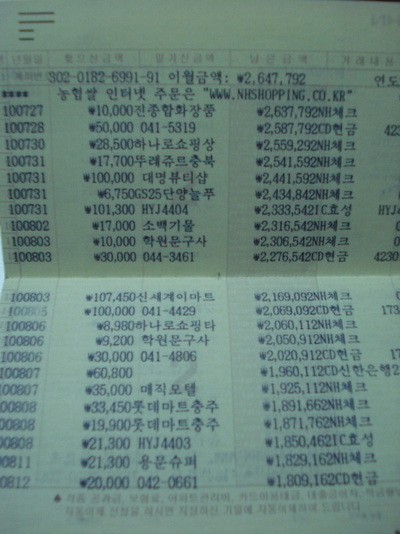
bank book
Totally random... but just another cool thing about Korea!